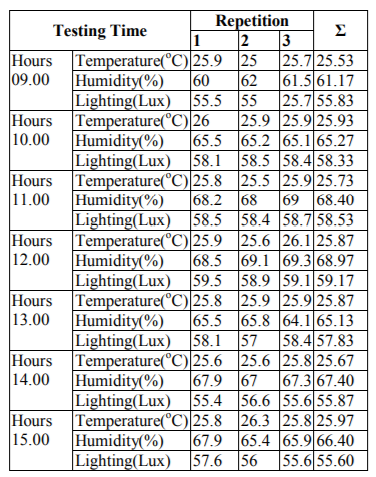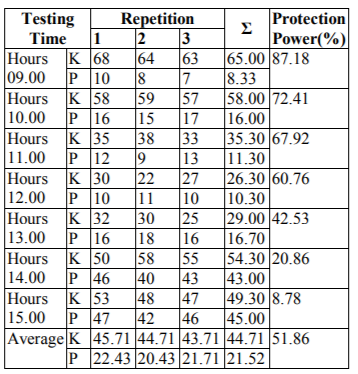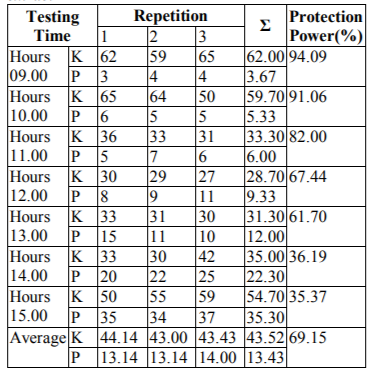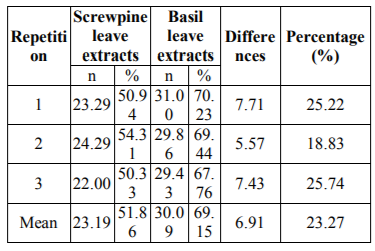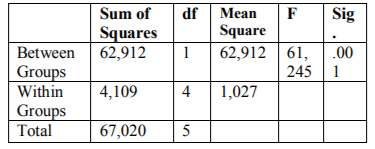Information
Journal Policies
Differences in Effectiveness between Screwpine and Basil Leaves as Repellent of Aedes Aegypti
Hajimi1,Viviana2,Asmadi3,Asep Tata Gunawan4
2.Poltekkes Kemenkes Semarang. Jln. Tirto Agung Pedalangan, Banyumanik, Semarang 50239, Indonesia.
Copyright : © 2017 . This is an open access article distributed under the Creative Commons Attribution License, which permits unrestricted use, distribution, and reproduction in any medium, provided the original work is properly cited.
Background: Dengue fever caused by Aedes aegypti is a health problem in Indonesia because there are still many endemic areas. To date, several studies have been conducted using plant extracts as a repellent for Aedes aegypti.
The Objective: The aim of this research is to know the effectiveness of screwpine leaves (Pandanus amaryllifolius roxb) and basil leaves (Ocimum sanctum) as the repellent of Aedes aegypti.
Method: This research was a quasi-experimental study that was close to a real experiment, but it was impossible to control (manipulate) all relevant variables.
Result: The results showed that there was a difference between screwpine leaf extract (Pandanus amaryllifolius Roxb) and basil leaf extract (Ocimum sanctum) as the repellent to the number of mosquitoes with significant value p = 0.001. From the average difference of protection power of the extract, basil leaf extract had 3 hours protection better than screwpine leaf extract which only lasted 2 hours.
Conclusion:For the community, both of leaf extract can be used as they are relatively safe repellent for humans because they are made from natural ingredients.
Aedes aegypti, Screwpine Leaf, Basil Leaf, Repellent,Public Health and Community Medicine
1. Introduction
Dengue hemorrhagic fever (DHF) is one of the infectious diseases in the community that the number of sufferers tends to increase and spread more widely, especially attacking children. The primary vector that causes dengue is Aedes aegypti mosquito. Mosquitoes that become vectors are infected mosquitoes because they bite a sick human and viremia - the existence of the virus in blood - (Widoyono, 2011).
In 2015, the morbidity rate of Dengue Hemorrhagic Fever in West Kalimantan Province was 23.28 per 100,000 population (1115 cases) with the mortality rate of 1.35% (15 deaths), (Ditjen PP & PL. 2016).
Based on the research of Rina Marina and Endang Puji Astuti (2012) it was known that test of resistance against Aedes albopictus mosquito from screwpine leaves (P. amaryllifolius) was 93.5% higher than cup leaves (N. scutellarium) that were 87,5%. Meanwhile, Rilianti (2015) concluded that screwpine leaves ethanol extract at the concentration of 40% had the most effective repellent percentage as the repellent to Aedes aegypti mosquito resistance with effective doses 99% against the mosquito at the concentration of 73.24 %. Other research on basil leaf declared that minimal repellent concentration of basil leaf extract was effective to resist the bite of Aedes aegypti mosquito found at 80% concentration (Indriyati, 2005).
Based on the above data, the researchers are interested in researching the different effectiveness between screwpine (Pandanus amaryllifolius roxb) and basil leaves (Ocimum sanctum) as the repellent against Aedes aegypti mosquitoes. The researchers hope that the research can be accepted and applied by the community so that it becomes a contribution to the government and local health agencies in preventing dengue fever.
2. Materials And Methods
This study used a quasi-experimental design with the aim to reveal causal relationships by involving the control group in addition to the experimental group. But the separation of both groups was not by random technique. Specifically, this study aims to determine the effectiveness differences between screwpine leaf extract (Pandanus amaryllifolius roxb) and basil leaves (Ocimum sanctum) as a repellent against Aedes aegypti mosquitoes.
Analysis of Variance (ANOVA) test was used to see if there was any difference in effectiveness between the two natural repellents.
3. Results
Conditions of research sites and related information are presented in the following tables.
Table 1 showed the average result of the physical environment condition from the first repetition to the third repeat was 25.7 o C the highest and the lowest temperature was 25.53o C. Furthermore, the highest humidity was 68. 97% and the lowest was 61.17%. The table also revealed that lighting 55.87 lux was the highest and 55.6 Lux was the lowest.
The distribution of the number and average of mosquitoes perching using 85% screwpine leaf extract and control for 5 minutes of observation in 6 test times is presented in the following table.
Table 2 showed that the average yield of 85% screwpine leaf extract protection during the first repetition up to the third one was 51.86%. Although the average protection power is not up to 80% but from the above results is known the existence of protection above 80% that occurs at 09.00 hours of 87.18%. The lowest security took place at 15.00 at 8.78%.
The average Aedes aegypti mosquito that perches on the hands of probands by using the concentration of 85% basil leaves extract (Ocimum sanctum) is shown in the following table. Table 3 showed that the average yield of 85% basil extract protection concentration during the first repetition up to the third repeat was 69.15%. Although the average protection power was not up to 80%, the above results revealed the protection of above 80% that occurred at 09.00 (94.09%), at 10.00 (91.06%) and 11:00 (82%). The lowest protection took place at 15.00 hours for 35.37%. The distribution of mean frequency differences of 85% screwpine leaf and 85% basil leaf extract on mosquito perching strength are shown in the following table.
Table 4 showed that the average yield percentage difference of screwpine leaves and basil leaf extract on mosquito perching capacity was 6.91 or 23.27%.
Table 5 showed that the value of calculated F was 61,245 with significant p-value = 0.001 ≤ 0.05 indicating that H0 is rejected and Ha is accepted meaning there is a significant difference between screwpine leaf (Pandanus amaryllifolius Roxb) and basil leaf (Ocimum sanctum) extract as the repellent to the number of mosquitoes perching.
4. Discussion
The average protection power of screwpine leaf extract (Pandanus amaryllifolius roxb) does not reach 80%. But from the above results, it was known the protection of above 80% that occurred at 09.00 hours of 87.18% while for the lowest protection took place at 15.00 at 8.78%. These results are in line with Rasyid's research (2014) which states that there are significant differences between the number of mosquitoes perched before and after treatment of screwpine leaves.
Pandanus amaryllifolius Roxb with 85% concentration has resistance power to Aedes aegypti mosquitoes. However, the average numbers of perching mosquitoes tended to increase in every hour indicating the decrease of screwpine leaf extract protection capacity to reduce mosquito.
The more active ingredients contained in a plant, the greater the ability to reject mosquitoes (Shinta, 2010). This condition is indeed revealing of essential oils and other active substances contained in extracts of leaves of screwpine causing the differences in the number of mosquitoes that land from the effects of repellent. Solutions given is that to reach a maximum power of repellent, a dose of 100% mixed with other plants are expected to produce the power of above 80%.
The average protection power of basil extract does not reach 80% either. But from the above results was known the protection of above 80% that occurred at 09.00 hours for 94.09%, at 10.00 for 91.06% and 11:00 for 82% while for the lowest protection took place at 15.00 for 35.37%. The results are in line with Manaf (2012) study which states that the lotion from the essential oil of basil leaves has a repellent power against Aedes aegypti mosquitoes.
The presence of active substances in the form of saponins, tannins, alkaloids and essential oils in basil leaf extract causes differences in the number of perching mosquito. Similarly, solutions given is that to reach a maximum power of repellent, a dose of 100% mixed with other plants are expected to produce the power of above 80%.
The average percentage difference in power protection between screwpine leaf and basil toward mosquitos’ perched power was 6.91 or 23.27%. Furthermore, the test result of ANOVA showed the calculated F value = 61,245 with a significant value of p = 0.001 ≤ 0.05 denoting that there are important differences between the extracts of screwpine and extract of basil as a repellent to the number of perched mosquitoes.
With the same concentration, both plants have different power protection. Basil leaf extract had 3 hours protection while screwpine leaf extract lasted only 2 hours. Differences in protection power may occur due to the different active substance content that exists in both types of extract although there are several characteristics of the same substance. Both can reduce the power of mosquito bites but no one has a protection control of up to 80% so that both plant extracts are not recommended to be repellent. This occurrence may be due to the use of extracts of the leaves of screwpine and basil that only use concentrations of 85% obtained by dilution with ethanol so that the oil content in the extract of both the leaves do not last long because the ethanol speeds up the evaporation of the extracts in every testing hour.
5. Conclusion
The average effectiveness of screwpine leaf extract (Pandanus amaryllifolius roxb) as a repellent against Aedes aegypti mosquitoes was 51.86%. The average effectiveness of basil leaf extract (Ocimum sanctum) as the repellent against Aedes aegypti mosquito was 68.16%.
There was a significant difference between screwpine leaf and basil leaf extract as the repellent to the number of Aedes aegypti mosquitoes perched. To the public, it is recommended to use screwpine leaves, and basil leaves not only to serve as additives and natural perfumes in food, but also can be repellent mosquitoes because the sheet contains essential oils and flavonoids that can repel mosquitoes. However, further study is necessary to boost the protection power until 80%.
References
- Ditjen PP & PL. 2016. Data Angka Kesakitan Demam Berdarah Dengue di Indonesia Tahun 2014-2015. Direktorat Jenderal Pengendalian Penyakit dan Penyehat Lingkungan, Departemen Kesehatan Republik Indonesia, Jakarta.
- Indriyati. 2005. Uji Daya Tolak Ekstrak Daun Mindi (Mellia azedorach linn) dan Ekstrak Daun Kemangi (Ocimum sanctum linn) Sebagai Repelen Nyamuk Aedes Aegypti, Skripsi (Online), Fakultas Kesehatan Masyarakat Universitas Diponegoro, Semarang.
- Manaf, Syalfinaf. 2012. Efektivitas Minyak Atsiri Daun Kemangi (Ocimum Basillicum L.) Sebagai Bahan Aktif Losion Anti Nyamuk Aedes aegypti L, Skripsi (Online), Jurusan Biologi FMIPA Universitas Bengkulu.
- Rasyid, Al Ghazaly. 2014. Perbedaan Efektivitas Daya Tolak (Repellent) Ekstrak Daun Jeruk Purut (Citrus hystrix D.C.) Dengan Ekstrak Daun Pandan Wangi (Pandanus amaryllifolius Roxb) Terhadap Daya Hinggap Nyamuk Aedes Aegypti Di Kota Pontianak, Skripsi, Jurusan Kesehatan Lingkungan, Poltekkes Kemenkes Pontianak, Pontianak.
- Rilianti, Dwitya. 2015. Daya Tolak Ekstrak Ethanol Daun Pandan Wangi (Pandanus amaryllifolius) Sebagai Repellent Terhadap Nyamuk Aedes Aegypti, Skripsi (Online), Lampung: Laboratorium Kimia Organik dan Laboratorium Zoologi Universitas Lampung, Bandar Lampung.
- Rina, Marina, dan Endang Puji Astuti. 2012. Potensi Daun Pandan (Pandanus Amaryllifolius) Dan Mangkokan (Notophanax Scutellarium) Sebagai Repelen Nyamuk Aedes Albopictus, Skripsi (Online), Ciamis: Balai Litbang P2B2 Ciamis, Badan Penelitian dan Pengembangan Kesehatan, Kementerian Kesehatan Republik Indonesia.
- Shinta. 2010. Potensi Minyak Atsiri Daun Nilam (Pogostemon cablin B.), Daun Babadotan (Ageratum conyzoides L), Bunga Kenanga (Cananga odorata hook F & Thoms), dan Daun Rosemarry (Rosmarinus officinalis L ) sebagai Repelen terhadap Nyamuk Aedes aegypti L. Jakarta: Pusat Teknologi dan Intervensi Kesehatan.
- Widoyono. 2011. Penyakit Tropis (Epidemiologi, Penularan, Pencegahan & Pemberantasannya, Erlangga, Jakarta.





